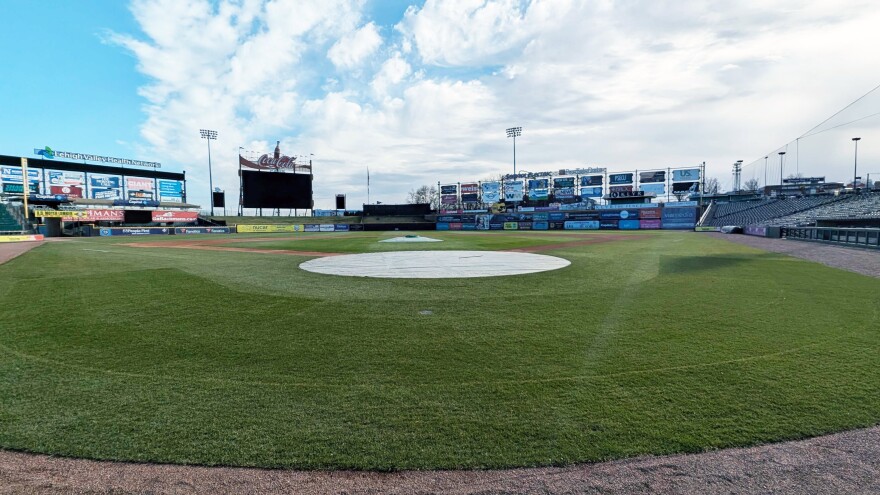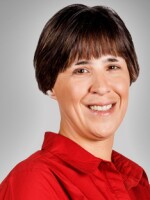ALLENTOWN, Pa. — Baseball is a game of inches.
From the 60 feet, 6 inches between home plate and the pitcher’s mound to the 90 feet separating the bases, every inch matters.
At Coca-Cola Park, those dimensions extend to 323 feet in left field, 400 feet in center, and 325 feet in right.
Yet for Andy Gossel and Mike Conrad, the most critical measurement lies hidden — 4 inches beneath the surface.
That thin layer is the foundation of the field’s performance and its appearance, and careful maintenance is what gives fans that unmistakable “wow factor” when they first step into the stadium.
“What you see on the surface is different than the consistency of the 4 inches that we're trying to maintain,” said Gossel, director of field operations for the Lehigh Valley IronPigs.
"It's been a tightrope, to say the least."Andy Gossel on getting Coca-Cola Park's field ready for the season
And this offseason underscored one fact — there’s no spring training for the grounds crew before the regular season begins and the playing surface has to be just right.
“It's been a tightrope to say the least,” Gossel said on a very chilly Wednesday morning.
“The fact that [the holiday lights display] Illumination didn’t allow us to do some of our work on the infield dirt that we would normally like to do in the fall.
“And then this year, on top of that, the ground was pretty frozen until the first week of March. It was definitely a late start to the spring.
“So on Tuesday, we had a contractor in to finish laser grading our infield dirt, and he finished an hour and a half before the first [team] workout.”
Precision on the field

For those unfamiliar, laser grading plays a significant role in the construction or renovation and rehabilitation of baseball fields.
It involves using laser technology to bring an infield back to the desired surface elevation.
At Coca-Cola Park this week, that meant spreading 25 tons (about 50,000 pounds) of infield mix just to help level things out — only three days before the season opener.
“Over time, due to weather, rain, foot traffic, wind, you just start getting low," Gossel said.
"You start losing some of that infield mix and it gets taken off the field one way or another, including on uniforms or cleats. So we were a little bit low across the board.”
“I'd rather have that done at least a week ahead of time, to give us some time to adjust our moisture and get everything dialed in and tweaked. But we made the deadline."Andy Gossel, director of field operations at Coca-Cola Park
Once the mix was dumped, it was spread out and tilled four or five times to blend it before a laser was used to provide an accurate and consistent grade, he said.
“And then we rolled it tight, tweaked that, rolled it again,” Gossel said.
“So it was, all told, probably 12 to 14 hours worth of work over Monday night and Tuesday. Then we put conditioner over the top and tried to adjust the water and dial it in.
“I'd rather have that done at least a week ahead of time, to give us some time to adjust our moisture and get everything dialed in and tweaked," he said.
"But we made the deadline.”
‘That grass was going to die’

Gossel and Conrad are the only two full-time, year-round guys on the IronPigs grounds crew. And if you think their job seems easy, think again.
“On a typical homestand week, we're basically here from 9 a.m. until about midnight most days," Gossel said. "So for a homestand week, the average of 95 or 100 hours is typical.”
Through every hour of work, their main goal is consistency. It means a field that’s not too wet and not too dry, along with a grass length that’s always the same so ground balls don’t slow down or skip too quickly.
And this year, they knew part of their offseason maintenance plan would require replacing part of the grass field. It’s the nature of having a ballpark that’s now a year-round facility.
“I don’t think there was a whole lot of concern,” Gossel said of Illumination, the holiday lights extravaganza Coca-Cola Park held for the very first time over the winter.
“It was more just the uncertainty,” added Conrad, the manager of field operations.
“We talked to some teams that had the same type of event, but everyone’s obviously going to be a little bit different in the way they set things up.
“It’s the uncertainty of, ‘OK, we’re going to put that there and that there and what’s going to happen?’”
What happened was something both men said they fully expected.
Great to have your class visit again this year. Always glad to host the next generation of turf managers. #sodiscomingfriday https://t.co/MSJkLQDA0M
— IronPigs GroundsCrew (@PigsGroundsCrew) March 19, 2025
“That grass was going to die. We’re going to have to replace that. We had igloos behind home plate, and 2,000 square feet of grass was all dead.”
And so, with Mother Nature constantly pushing her finger on the front/defrost button, they looked for a recent break in the weather for the removal of the old sod.
Luckily, it meant little more than a quick trip out to the parking lot near the grounds shop — just beyond the left field wall. It’s where the “sod farm” exists, from which Gossel and Conrad “harvest."
"You can pretty much drop that on the field, put it in place, and it's heavy enough where it's not going to move.”Andy Gossel, director of field operations at Coca-Cola Park
“The sod comes in large rolls about 4 feet wide by about 50 feet long, and they're about an inch and a half thick,” Gossel said.
“And so you can pretty much drop that on the field, put it in place, and it's heavy enough where it's not going to move.”
The result is a surface on which the players can pretty much be on immediately.
“It’s just something the sod industry has developed over the last 10 to 15 years," Gossel said.
"With stadiums hosting year-round events or multiple events, you end up having to replace it quickly and the field has to be ready and playable and safe for million-dollar athletes very quickly.
“Ideally, we would like to have been able to sod it earlier and give it more time to just settle in and help out and root a little bit more, but those sod pieces are big enough that you can get on it right away.”
A labor of love
“I like to jokingly tell people I have the least-traveled path to Triple-A baseball,” Gossel said.
He spent decades as an educator and a high school baseball coach. As it turns out, it provided a solid foundation for learning to maintain a pristine baseball field.
Conrad graduated from Kutztown University with a degree in sports management and discovered he’d rather be in the dirt than working in the front office.
“I took a shot in the dark and moved down to El Paso, Texas for like $8 an hour, and joined the grounds crew down there, came back home after that,” he said.
If you spot them on Opening Day watering the infield dirt, they’re trying to maintain the moisture on and below the custom blend of clay, sand and silt. It’s a precisely engineered mixture called Dura Edge, and it needs to be smooth, thus it needs the proper moisture.
You’ll also see them groom the infield with steel mesh drags to keep the playing surface safe and consistent through the game. Doing that every three innings helps close cleat marks and other indentations that could lead to bad hops, causing a fielding error or an injury.

Earlier this week, Gossel monitored the work of about nine engineers brought into the ballpark not only to work on the field, but pull up and replace the artificial turf in the bullpen areas. It’s the first time they’ve been overhauled since Coca-Cola Park first opened.
In the leadup to the first pitch at 6:05 p.m. Friday, every little detail has to be perfect.
“Up until about a week ago, we weren't sure we weren't going to have to use a little green turf pigment and turf dye to help bring [the field] along a little bit,” Gossel said. “But we haven't had to, and we’ve had a couple days of really good weather in the last two weeks.
“We put our first granular fertilizer down a week ago Saturday, we did a fertility spray here this past Sunday, and lo and behold, it's greening up pretty well.”
Fans pouring through the gates to welcome back baseball and help kick off the 2025 season might notice that, but there’s so much more to the art and science of the four inches of what’s beneath the ball players’ feet.
“I always tell people, ‘When you were a kid, you played with a ball of clay or Silly Putty or Play Doh. If that dries out and you just soak it, it's just gonna be a mushy mess on the outside, but the inside is still going to be hard,” Gossel said.
“As long as we're doing our job, it means hopefully nobody really notices us too much, other than the ‘wow factor.’"Andy Gossel, director of field operations at Coca-Cola Park
“Well, if you start trying to put cleats into a mushy mess on the outside, but it's hard on the inside, that's not going to be a good, consistent playing surface. So for us to try and maintain consistent moisture through four inches is a constant thing.”
Both men talked about being part of something bigger and part of an organization that takes pride in “providing a great experience every single time for every single fan.”
“There’s a lot of people that have to do their job to make that happen (including part-time grounds crew that bring numbers to 6 on game nights), and hopefully we do it well enough that people just don’t give it a second thought,” Gossel said.
“As long as we're doing our job, it means hopefully nobody really notices us too much, other than the ‘wow factor.’ When fans walk in and it’s like, Ohhhh, we’re back at the ballpark and that's what it should look like.”



